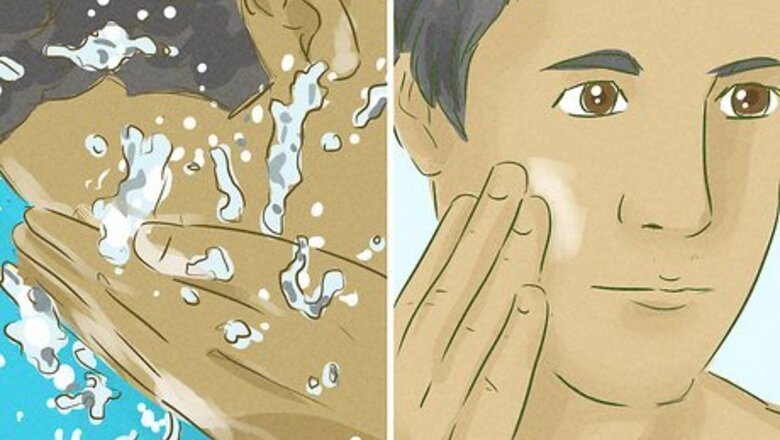
views
Makeup
Wait until the wound heals a little before using makeup. If you cover a fresh, open wound with makeup, you could irritate the damaged skin or trap contaminants in the cut. Don’t try to conceal your cut until it’s had a chance to heal for a couple of days and is covered with new skin. It’s okay if the wound is still a little red and tender. Just make sure it’s closed up. In the meantime, look for a band-aid that’s designed to look subtle and blend in with your skin. Look for clear or skin-toned bandages at the pharmacy.

Wash and moisturize your face before applying makeup. Lather the cleanser between your fingers before gently rubbing it on your face. Be sure to go over the area with the cut—just use light pressure. After splashing water on your face and patting it dry, apply a dime-sized amount of moisturizer to your entire face to keep your skin healthy and glowing. Consider using a moisturizing cream with vitamin C because it can nourish the new skin growing over the cut. Use a gentle moisturizer that’s free of dyes, fragrance, or alcohol to avoid irritating the cut.
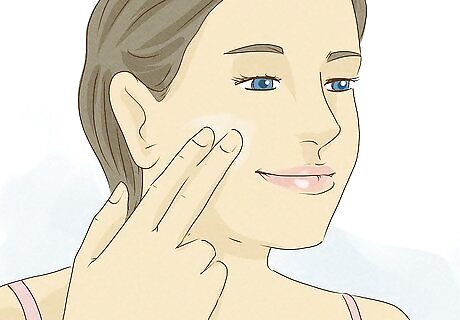
Prime your skin and the cut to ensure an even texture. A primer will help the color corrector and concealer go on smoothly. Choose a matte primer to help fill in any fine lines and crevices on the scar. Swipe a dime-sized amount on your face with clean fingers. Tap a little primer directly into the scar to fill it in. Some primers contain anti-inflammatory and anti-microbial ingredients, which is perfect to help nourish the new skin that’s formed over the cut.
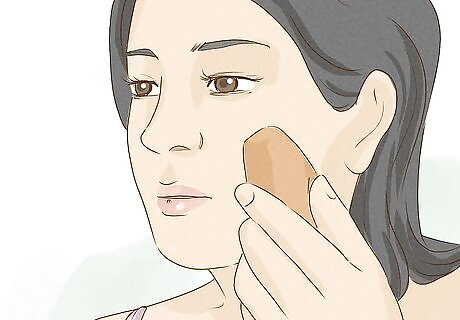
Apply a thin layer of color corrector to the cut with a makeup sponge. Using a sponge to cover your cut is better than your finger or a brush because the porous surface of the sponge can apply product into the small nooks and crannies of the cut. Dampen the sponge slightly before dipping it in the concealer. Dab the entire area with a very thin layer, starting at the center of the cut (the most noticeable part) and moving outward toward the edges. Add a second or third layer if you need to. Use a yellow color corrector to mask the stark red lines of the cut. Yellow works well with every skin color, but you have pinkish fair skin, opt for a yellow color corrector with peachy undertones. Green color corrector will help mask dark-colored redness on fair, olive, and dark skin. Opt for red or dark orange color corrector to mask purple or brown areas on dark complexions. The darker your complexion, the darker the hue of red or orange will work for you. Use a lilac concealer to mask brown or yellow spots on fair skin with yellow undertones. Avoid using lilac on darker skin tones.

Use a brush or sponge to apply concealer for extra coverage. Color corrector isn’t all that noticeable, but it still might stand out from the other skin on your face. Choose a concealer that's within 1 to 2 shades of your skin tone so it's not too bright or so dark that it's noticeable. If you’re buying a new concealer, test it on the top of your hand to make sure it’s a good match. You can also cover the color corrector with a full-coverage foundation. Be careful not to overdo it when you apply concealer or foundation to the cut—cakey makeup can stand out just as much as the original cut. Dust on a light setting powder when you’re done to help the makeup stick.
Hair and Hats

Wear your hair down to cover a cut near the side of your face. If you have medium to long hair and the cut is located near your temple, the side of your forehead, or the side of your cheek, let your hair hide the cut for you. You can wear your hair straight, but relaxed waves are more voluminous and will provide more coverage. Use an anti-frizz serum or medium-hold texturizing mousse to keep your locks tamed and in place.
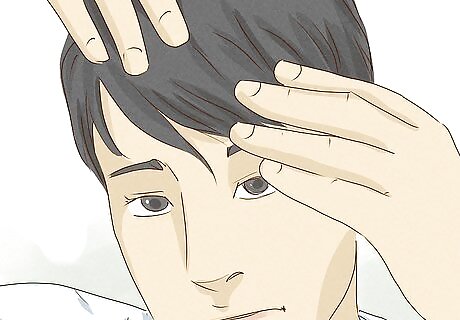
Create faux-bangs with a deep side-part to cover forehead cuts. A deep side part aligns with the outside edge of your eyebrow or even farther toward your ear. Use the blunt edge of a comb or brush to draw the part line, making sure it’s on the opposite side of the cut. That way, the bulk of your hair will be swooping over your forehead to the opposite side. If you’re battling a cowlick, use bobby pins to hold the swooped hair in place. It may be easier to make a deep side part with damp or wet hair.

Wear a brimmed hat, beanie, or baseball cap to cover hairline cuts. A hat can make cuts less obvious and protect them from the sun while they heal. Choose a style of hat that works for you and is appropriate to where you’ll be wearing it. Make sure the brim of the hat doesn’t fall directly on top of the cut because it may rub against it and irritate the newly repaired skin. If the cut is inflamed or raised, a loose beanie will give you coverage without applying too much pressure to the sensitive area.

Have a stylist cut heavy bangs to hide a cut on your forehead or temples. Heavy bangs are a commitment, but if you’re desperate to cover the cut (and if you’re feeling bold), go for it! If your face is round, opt for thick, slightly side-swept bangs (sweeping toward the side with the cut). If your face is long or square-shaped, ask your stylist to cut straight-across bangs that end at or below your eyebrows. While some face shapes look best with certain types of bangs, don't let that stop you from trying the style you like best. If you’re avoiding hair salons to stay safe during COVID, try cutting your own bangs. Check out a YouTube tutorial on how to cut the style you want.
Wound Care
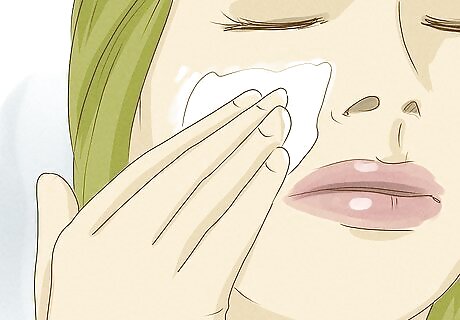
Wash the healing cut with mild soap 2 times a day or after sweating. Even if the cut isn’t fresh or bleeding, it’s important to clean it so it doesn’t get contaminated with debris or germs. Use a mild hand soap and water—don’t use your usual facial cleanser because certain ingredients may irritate the wound. You can wash the rest of your face with your usual cleanser, just avoid the cut as much as possible.

Apply petroleum jelly after washing the cut to prevent scarring. Petroleum jelly will keep the wound moist, allowing the skin to heal without drying out and forming a scab (which can leave a scar). Put a pea-sized amount or less onto a clean finger or cotton swab and dab it onto the cut. Apply petroleum jelly after each time you wash the cut. Once you’ve applied the jelly, try to avoid touching the cut as much as possible, and definitely don’t pick at it! Picking will destroy the new skin forming over the wound and prolong the healing process.
Put a band-aid over the cut while it’s fresh. An adhesive bandage will help protect your wound from infection and hold in moisture from ointments, which promotes faster healing. Wear the bandage for at least 24 hours so that the cut has time to close up before you expose it to the air. If you don’t like the idea of having an obvious band-aid on your face, look for see-through or skin-toned options in your drug store. In a pinch, try covering the wound with a liquid bandage, such as New Skin. Once it dries, you can apply makeup over it.
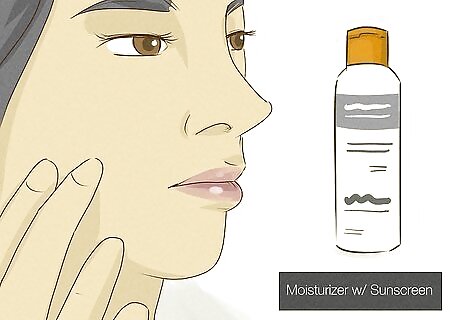
Use sunscreen every day to minimize the risk of discoloration. Exposing recently healed (or healing) wounds to the sun can cause newly formed skin to take on a reddish or brownish color. Make sure your facial moisturizer has at least SPF 15 sunscreen, or apply SPF 30 (UVA and UVB protective) sunscreen before putting on your makeup. Sunscreen is most effective when you apply it about 15 minutes before sun exposure. Wear a hat and avoid the sun as much as possible to help prevent scarring.

Increase your daily intake of vitamin C to speed up healing. Fruits and veggies like berries, oranges, kiwi, cantaloupe, brussels sprouts, broccoli, and peppers are all packed with this essential nutrient. Vitamin C helps your skin heal because it prompts your body to create collagen to heal the wound. Lots of foods with vitamin C also contain vitamin A, which is necessary for your skin to produce new skin cells. If allergies or dietary restrictions prevent you from getting enough vitamin C from food, talk to your doctor about taking a supplement.
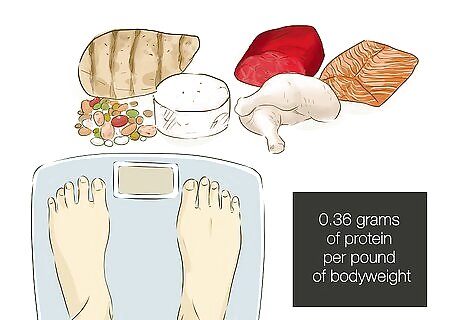
Eat lots of high-protein foods while you heal. Your body uses protein to repair muscle and skin tissue and fight off infections. The amount of protein you need depends on factors like your age, sex, overall health, and bodyweight, so ask your doctor for advice on how much to eat. Lean ground beef, fish, chicken, turkey, eggs, cheese, and milk are all good sources of protein. Vegan options include tofu, tempeh, seitan, beans, lentils, nuts, seeds, and wheat germ. Consider adding a scoop of protein powder to yogurt, oatmeal, and smoothies to increase your intake.

Drink enough water every day to promote healing. Water allows nutrients to travel throughout your body, delivering them to areas that need healing the most. Aim to drink about ⁄2 fluid ounce (15 mL) of water per 1 pound (0.45 kg) of body weight. For instance, if you weigh 140 pounds (64 kg), try to drink 70 fluid ounces (2,100 mL) of water per day. If you regularly do high-intensity exercise, you may need more water than the recommended daily amount. If you drink alcohol, drink an extra 8 fluid ounces (240 mL) of water for every 1 alcoholic beverage to prevent dehydration.




















Comments
0 comment